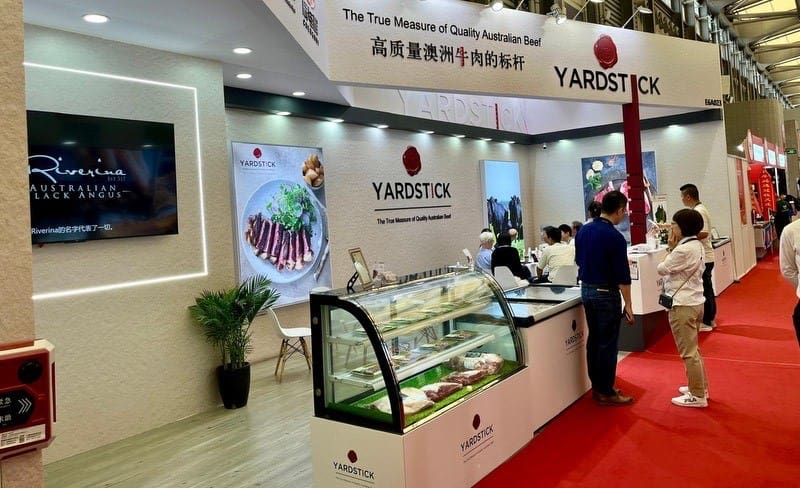
NEWS is still only sinking in about China’s relaxation of trade access for five large Australian beef export processors overnight (see today’s separate report), but already stakeholders are studying the implications.
With a combined daily production capacity of around 6000 head, the five plants whose suspensions have been removed represent a substantial chunk of Australia’s potential export trade into China.
Firstly, its worth looking at the type of Australian plants that were subject to the earlier suspensions.
Almost without exception, they were principally processing higher quality grainfed cattle, including considerable numbers of Wagyu, producing mostly chilled beef.
Some observers at the time the suspensions were activated suggested the type of plants were designed for maximum effect, with a tense political relationship between Australia and China at the time, leading to trade bans on wine, barley, lobsters and other items.
SIAL trade show lights up
China’s enormous SIAL food trade show being held in Shanghai this week lit up this morning on the news of expanded Aussie beef access.
Several senior Aussie meat traders in attendance at the event said new inquiry from Chinese interests was clearly evident around the trade booths this morning.
So what does it mean for Aussie export prospects?
Firstly, improved China access (and the prospect of more to come) does not represent a free-for all for Australian beef.
The China market remains limited to HGP-free cattle only, and a big majority of Australian grainfed cattle (plus some grassfed) continue to receive implants, for productivity reasons. It is the key reason why only modest amounts of US beef finds its way into the China market, with implants used almost universally in US fed cattle.
Historically, China has taken a wide spectrum of Australian product, but volume was skewed towards the cheaper commodity-type end.
“The attraction is they can take commodity type items in volume,” one exporter told Beef Central. “If other markets are struggling for those items, you have another option in China,” he said.
“The Chinese still do take some high-end Australian meat, but the shine has come right off that segment in the market, due to the state of the local economy,” he said.
The commodity end of the China market had been “absolutely swamped’ with South American meat over the last two years (see statistics below), and current demand was ‘very flat’, another prominent exporter at today’s SIAL trade show said.
“They’ve been sitting on really high inventories – I think that is slowly improving, but we think grainfed is the segment with best prospects now for Australia. And that works well, given the plants that had suspensions lifted this morning are almost all grainfed,” he said.
Re-focus on higher quality grainfed?
A number of export trade contacts feel Australia’s future in the China market, with better market access, will move in a very different direction from where it has sat, historically.
Back in 2019, Australia was in an arm-wrestle with Brazil, supplying mostly generic grassfed product sold on price. Brazil now dominates that category, but prices for generic lean beef have come under considerable pressure since 2022-23.
Traders that Beef Central spoke to see better quality chilled and perhaps frozen grainfed as Australia’s main future in China, rather than generic price-driven grass commodity beef. That applies, particularly, because of the looming shortage of chilled and frozen grainfed cuts out of competing exporters like the United States.

JBS Australia’s SIAL trade site yesterday, before the suspensions were lifted. Yardstick is one of the company’s non-HGP programs
It is no coincidence that quite a number of large Australian grainfed beef supply chains have launched or expanded HGP-free programs over the past three to six months. Here is a recent example of as new large HGP-free program, launched recently by JBS. Are they anticipating improved access to China? Possibly.
Dialogue with Australian supply chain managers suggests that any growth in Australian grainfed into China will not come at the expense of feeding HGP-treated cattle, but in addition to. That suggestion is supported by this morning’s release of quarterly feedlot survey results, showing Australia hit a new record number on feed in the March quarter.
However it would take some months for the longer grainfed production cycle to start to align with the improved China access, Beef Central was told. One supply chain manager said it might take six months.
He said his company had been taken by surprise when last night’s approvals came through.
“We thought it would happen during the Chinese Premier’s upcoming visit to Australia,” he said.
“But we are seeing demand for better quality grainfed type product in China, despite the current tough financial climate here,” he said.
“The trade up here has been so confident that something was about to happen, because there’s a big hole coming, in terms of the lack of availability of US grainfed beef – and the Chinese end-users are acutely aware of that.”
“That’s the hole Australian needs to fill – not fighting with Brazil for who sells the cheapest beef.”
“That good quality grained product sits nicely in the middle – particularly for food service in China – they use of a lot of grainfed in hotpots and other regional cooking styles, which are increasingly popular with people dining out, when money is tight.”
“But it’s been tough enough here in China over the past 12 months. A lot of smaller importers/traders have gone out of business, because of how tough the economy is. Some were speculating on big licks of Brazilian meat that was worth considerably less, by the time it hit cold storage.”
Good prospects for further plant approvals
With the first five beef plants now secured in regaining China access, attention is now focussing on the 14 beef and sheepmeat plants which have not previously held China access, but which have applications in place.
Incredibly, some of those applications have been pending for eight to ten years, and include at least some plants that have already been audited by Chinese authorities.
Beef Central understands from good industry sources that those approvals for trade are likely to happen before Christmas this year, and possible sooner than that. Because of the length of time that has passed, some may have to undergo another audit first.
China by the numbers
So how significant is China for Australian beef exporters, and how significant is Australia to China?
In April, Brazil exported 101,000t of beef to China, compared with Australia’s 14,800t.
For calendar 2023, Brazil accounted for 43pc of China’s total imported beef requirements of an incredible 2.77 million tonnes. Australia accounted for just 8pc.
In 2019, the last year before Australian plant suspensions started, Australian exports to China reached a record high of 300,000 tonnes – although that year was near all-time records for total beef production due to drought-driven herd liquidation.
Roll forward to 2023, exports to China were 206,000t, although that figure was up 30pc on the previous year.
Service kill relocation
One of the key structural changes that occurred when the plant suspensions described above started occurring three or four years ago was displacement of service kill customers, who were forced to shift plants in order to continue to access China customers.
The reduction in chilled processing capacity eligible for China also produced some unusual market distortions, including the freezing-down of high-quality Wagyu product that would normally be sold only chilled, in order to qualify under frozen access.
Certainly suspended plants like NCMC Casino, and John Dee near Warwick (still suspended), have in the past provided large service kills for customers, especially those in high quality Wagyu niches.
Some of those, at least, had to find new service suppliers allowing access to China to continue. Whether those customers now migrate back to plants like Casino remains to be seen, but in Casino’s case, it now kills a lot more of its own program cattle, and providing space may not be simply a matter of picking up where the service kill business left off in 2021.
